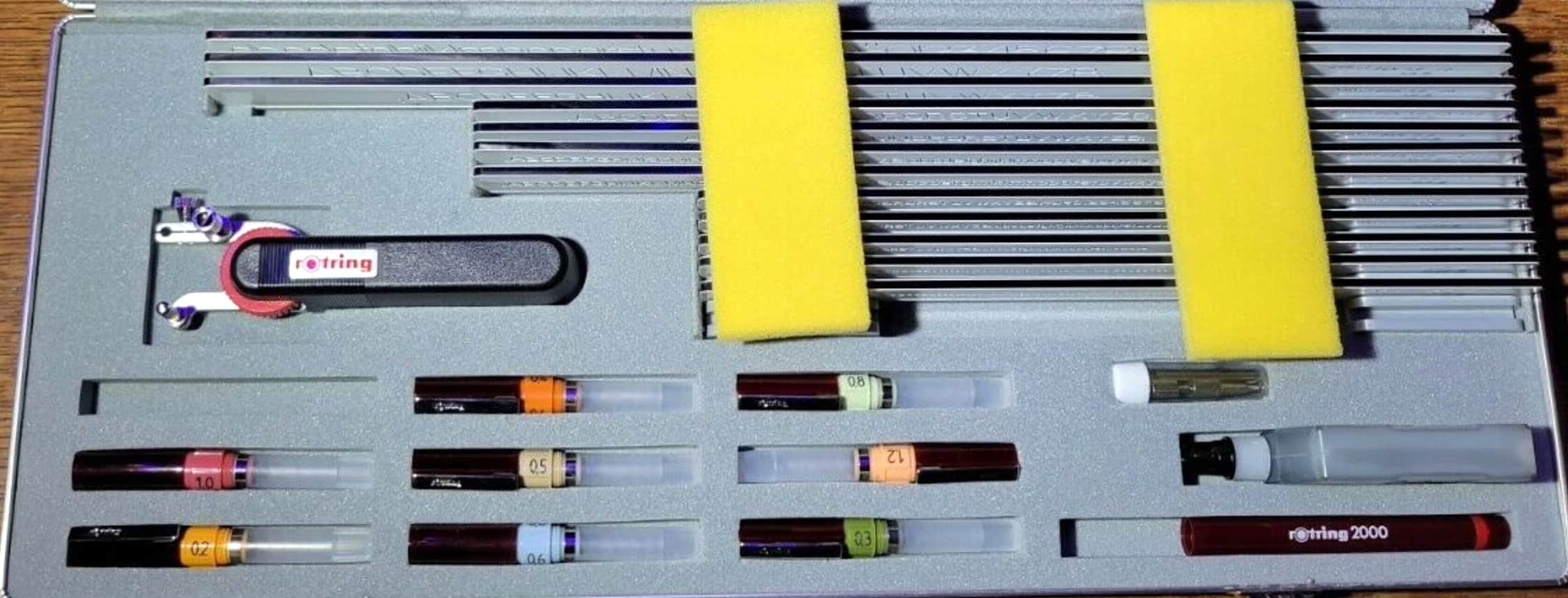Prior to the proliferation of computers, making super uniform letters was a challenge. Companies like Leroy and later Rotring developed “lettering systems” so letters could be drafted in a controlled, computer-like manner.
The Leroy lettering system was a product that started in the 1940s and allowed for draftsmen to do exactly this behavior. The Alvin drawing guide is similar concept but more less complex of a setup.
The Rotring Controlled Lettering System (CLS) is a very similar product that came much later — in the 1980s — but closely resumes the Leroy product, which was manufactured by Keuffel & Esser.
The Rotring CLS, model 461-900, was a set of 9 rulers and 6 pens, along with the other accessories ruled to do this sort of controlled writing. Smaller sets were also sold, like the 460 901 (9 rulers, no pens) as were larger ones, like the 461 900 (13 rules and 8 pens).
The system is made up of plastic rulers which have letters engraved on them, usually uppercase letters on the front and lowercase on the back.
The rulers were used alongside a tracing mechanism (sometimes compared to a pantograph duplicating device) which allowed the letters to be duplicated in the area above the ruler.
The adjustable tracing mechanism has two arms which determine the distance between the tracing and drawing components. Interestingly, as the letters get larger they tend to tilt and look like italics. This was offset by tilting the letters on the ruler.
The process was very simple:
- A paper was setup on a drafting or architect’s desk (sometimes called a drawing board) with a horizontal fixed bar at the bottom
- A ruler was placed against the horizontal bar and paper was placed under the rule
- An Isograph pen was inked and fitted into the tracing tool
- The tracing device was seated on horizontal slot at the bottom of the ruler, so that the letters would be placed consistently on the page
- The sharp tip of the tracing device was fit into a groove of the desired letter on the ruler
- The Isograph was pushed down so it was in touch with the paper (a spring prevented this when not in use) and the letter was traced
- The pen was lifted and the tracing tool and pen would stay in position while the ruler was slid to the next letter
This all sounds simple but it’s quite difficult in practice. For instance there is no mechanism for properly setting the distance between the letters. You can use the a ruler, but it’s an imperfect device in this respect. Many comics, which were known to use The Leroy lettering system have visible inconsistencies with the distance between letters as a result of this.
Also, it was often clear when parts of letters were traced over more than once. This was largely dependent the paper type and technique of the user.
Lastly, and worst of all, the depth of the letters on the ruler was very shallow, so it was quite easy to skip out of a letter and ruin a considerable amount of work in a moment.
The Controller Letter System included no instructions so was a difficult system to master and training by a mentor or guide would have been mandatory.
The CLS was automated with the Rotring NC-Scriber, which is a sort of portable plotter that does the above process automatically. The Rotring NC-Scriber never took off as a tool and was soon overtaken by the desktop printing revolution on the early Mac computers. Then, by 1990, Adobe Photoshop was released and the future was clear.
For Rotring collectors in 2022, this is a fun relic and possible hobby, but the sets are rare and generally sell for over $100. Meanwhile Leroy lettering kits are easier to fine and usually sell for much less.
